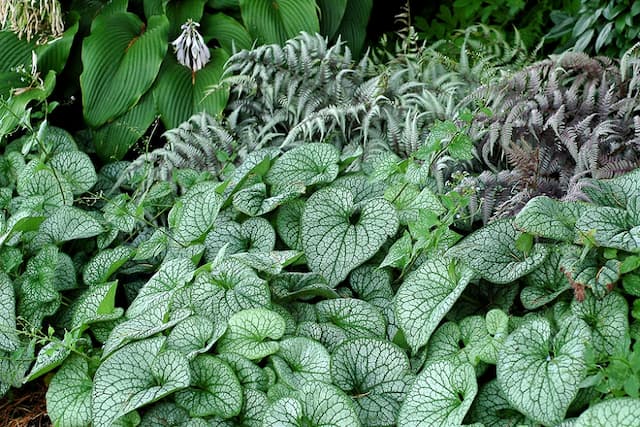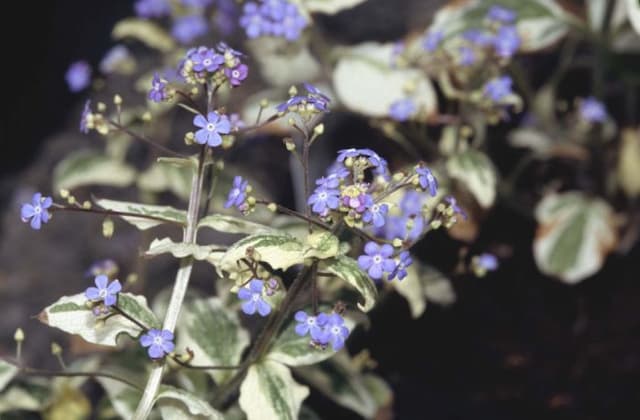Pulmonaria 'Raspberry Splash' (PBR)

ABOUT
Raspberry Splash Pulmonaria, also known as lungwort, is a perennial plant known for its unique and attractive foliage and flowers. The leaves of this plant are a standout feature, showcasing a green base with a liberal speckling of silver, giving them a stunning frosted appearance. These silver spots and blotches create an eye-catching contrast against the darker green color of the leaves, and the foliage often retains its beauty throughout the growing season. When the Raspberry Splash Pulmonaria blooms, it brings a delightful display of flowers that captivate onlookers. The blossoms emerge in clusters and typically bear a raspberry pink hue. However, the flowers can also display a charming shift in color as they mature, transitioning from pink to a softer tone of blue, creating an enchanting two-tone effect against the foliage. The blooms are funnel-shaped and delicately arranged in clusters, which adds to the ornamental value of the plant in garden settings. The contrasting foliage and flowers make the Raspberry Splash Pulmonaria a visually striking choice for adding texture and color to shaded garden areas or woodland settings.
About this plant
 Names
NamesFamily
Boraginaceae
Synonyms
Lungwort, Bethlehem Sage, Raspberry Splash Pulmonaria
Common names
Pulmonaria 'Raspberry Splash' (PBR).
 Toxicity
ToxicityTo humans
Lungwort, which includes the variety 'Raspberry Splash', is generally considered non-toxic to humans. There are no known toxic effects from ingesting any part of this plant.
To pets
Lungwort, including the 'Raspberry Splash' variety, is also not known to be toxic to pets. It is unlikely to cause any symptoms of poisoning if ingested by animals such as cats or dogs.
 Characteristics
CharacteristicsLife cycle
Perennials
Foliage type
Semi-deciduous
Color of leaves
Variegated
Flower color
Pink
Height
1 foot (30 cm)
Spread
1 foot (30 cm)
Plant type
Herb
Hardiness zones
4
Native area
Europe
Benefits
 General Benefits
General Benefits- Ornamental Value: Pulmonaria 'Raspberry Splash' adds visual interest to the garden with its spotted foliage and bright raspberry-pink flowers.
- Shade Tolerance: It performs well in shady areas where other plants might struggle, making it a valuable addition to woodland gardens or shaded borders.
- Easy to Grow: This plant is known for being low-maintenance and easy to care for, which is great for both novice and experienced gardeners.
- Attracts Pollinators: The flowers attract bees and butterflies, which are beneficial for pollination and the overall health of the garden.
- Seasonal Interest: Offers early spring blooms, providing color and interest in the garden after the winter months when few other plants are flowering.
- Drought-Resistant: Once established, Pulmonaria 'Raspberry Splash' is relatively drought-tolerant, reducing the need for frequent watering.
- Disease Resistant: This variety has been bred for resistance to common diseases, helping ensure a healthier plant with less need for chemical treatments.
 Medical Properties
Medical Properties- This plant is not used for medical purposes.
 Air-purifying Qualities
Air-purifying QualitiesThis plant is not specifically known for air purifying qualities.
 Other Uses
Other Uses- Lungwort 'Raspberry Splash' can be used as a natural dye source for fabrics, offering varying shades of green or brown depending on the mordant used.
- The spotted leaves of Lungwort 'Raspberry Splash' can be a creative addition to pressed flower art thanks to their unique patterns and colors.
- Lungwort 'Raspberry Splash' can provide a unique flavor when used as an edible garnish for fancy dishes, although it's not commonly consumed.
- The plant's ability to thrive in shady spots makes it a natural choice for creating fairy or miniature gardens under trees or in darker garden nooks.
- The foliage of Lungwort 'Raspberry Splash' can be used in a living mulch system, providing soil moisture retention and weed suppression benefits.
- Lungwort 'Raspberry Splash', when planted densely, can function as a soft groundcover that prevents soil erosion on slopes or banks.
- The early flowers of the Lungwort 'Raspberry Splash' can serve as a crucial early-spring nectar source for emerging pollinators.
- Lungwort 'Raspberry Splash' plants can be used as a subtle way to mark or outline paths in a woodland garden due to their mound-forming habit.
- The contrasting colors of the leaves and flowers make Lungwort 'Raspberry Splash' a visual teaching tool in botanical education for demonstrating plant variegation.
- Garden photographers can use the unique appearance of Lungwort 'Raspberry Splash' to compose striking macro photographic scenes or as a backdrop for photographing other insects and plants.
Interesting Facts
 Feng Shui
Feng ShuiThe plant Lungwort is not used in Feng Shui practice.
 Zodiac Sign Compitability
Zodiac Sign CompitabilityThe plant Lungwort is not used in astrology practice.
 Plant Symbolism
Plant Symbolism- Hope: Pulmonaria, commonly known as Lungwort, symbolizes hope due to its early spring bloom, signaling the end of winter and the promise of new life.
- Healing: With a name that hints at lung health, Lungwort has been traditionally used in herbal medicine, often associated with curing respiratory issues, thus symbolizing healing.
- Protection: Historically, Lungwort has been used in folk medicine to ward off evil spirits and diseases, representing a symbol of protection.
- Longevity: Pulmonaria plants are known for their resilience and ability to thrive in tough conditions, symbolizing long life and perseverance.
 Water
WaterFor Lungwort 'Raspberry Splash,' it's important to keep the soil evenly moist, especially during the growing season in spring and early summer. Watering should be done deeply once the top inch of soil feels dry, which may be approximately once a week, though this frequency can vary based on climate and weather conditions. The goal is to provide the plant with roughly 1 gallon of water every week, but this should be adjusted to ensure the soil doesn't become waterlogged or overly dry. During hot, dry spells, additional watering may be necessary, and during the winter months, watering should be reduced as the plant's growth slows down.
 Light
LightLungwort 'Raspberry Splash' thrives in partial shade, as this mimics its natural woodland habitat. The best location would offer some morning sun followed by afternoon shade, or dappled sunlight throughout the day. Avoid placing it in full sun, as this can scorch the leaves, and likewise, too much deep shade can reduce flowering and cause the foliage to become less vibrant.
 Temperature
TemperatureLungwort 'Raspberry Splash' prefers temperate conditions and can tolerate a range of temperatures from about 50 to 75 degrees Fahrenheit, which is commonly found in many gardening zones. It's hardy and can withstand winter temperatures down to about -20 degrees Fahrenheit but should be protected from extreme frost. The ideal temperature range for promoting good growth and vibrant blooms is between 60 to 70 degrees Fahrenheit.
 Pruning
PruningPruning Lungwort 'Raspberry Splash' helps to maintain its shape and encourages healthy growth. After the plant flowers in the spring, deadhead the spent blooms to promote a second, albeit smaller, flush of flowers. Prune back any damaged or dead foliage in early spring or immediately after flowering to keep the plant looking tidy and to encourage air circulation. Pruning is typically needed once a year; however, occasional removal of damaged leaves throughout the growing season is beneficial.
 Cleaning
CleaningAs needed
 Soil
SoilLungwort 'Raspberry Splash' thrives best in a soil mix that is well-drained yet retains moisture, rich in organic matter with a pH ranging from 6.0 to 7.0. A blend of loamy garden soil, compost, and a small amount of perlite or sand would create an ideal environment for this plant.
 Repotting
RepottingLungwort 'Raspberry Splash' does not need frequent repotting; it typically should be repotted every 2-3 years to refresh the soil and accommodate root growth.
 Humidity & Misting
Humidity & MistingLungwort 'Raspberry Splash' prefers moderate to high humidity levels but is quite tolerant of a range of conditions; aim for a humidity level of around 40-50%.
 Suitable locations
Suitable locationsIndoor
Place Lungwort 'Raspberry Splash' in bright, indirect light; keep soil moist.
Outdoor
Plant in partial shade, moist soil, shelter from harsh sun.
Hardiness zone
4-8 USDA
 Life cycle
Life cyclePulmonaria 'Raspberry Splash', commonly known as lungwort, begins its life cycle as a seed, which, after a period of dormancy and once conditions are optimal, germinates and sprouts into a seedling. The seedling establishes itself and grows into a vegetative plant, producing characteristic leaves with silver spots and developing a strong root system. As the plant matures, it enters the blooming phase, typically in early spring, showcasing clusters of pink to raspberry-colored flowers that attract pollinators. After pollination, the flowers develop into fruit containing seeds, completing the reproductive cycle. The lungwort then enters a period of senescence during the hotter summer months, where it may die back partially, only to regrow from the root system as the weather cools. This perennial plant continues its cycle annually, emerging from dormancy each spring to repeat the process.
 Propogation
PropogationPropogation time
Spring-Early Summer
Pulmonaria 'Raspberry Splash', commonly known as Lungwort, is best propagated by division. The optimal time for dividing lungwort is in the fall after the plant has finished flowering or in the early spring just as new growth begins. To propagate by division, carefully dig up the plant, making sure to keep a good amount of soil around the roots. Gently pry or cut the plant into smaller sections, each with several shoots and a healthy supply of roots. Replant these divisions immediately into moist, well-drained soil, spacing them about 12 inches (approximately 30 centimeters) apart to allow for growth. Water the newly planted divisions thoroughly to help establish them. This method is effective because it maintains the characteristics of the parent plant and allows the gardener to quickly increase their stock of lungwort.









